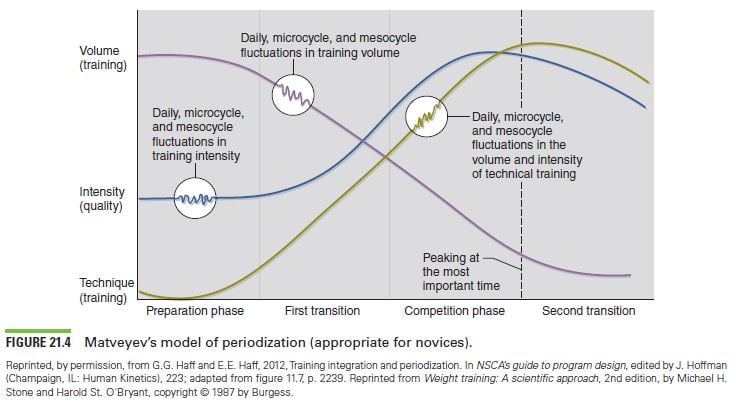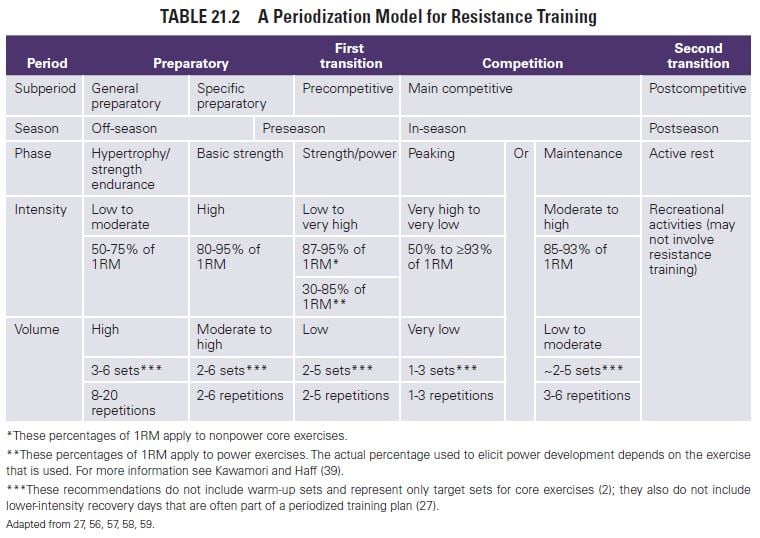Preparatory Period
by Essentials of Strength Training and Conditioning, Fourth Edition
Kinetic Select
September 2020
This excerpt from the Essentials of Strength Training and Conditioning outlines what training typically looks like in the preparatory period, or off-season.
The following is an exclusive excerpt from the book Essentials of Strength Training and Conditioning – 4th Edition with Web Resource, published by Human Kinetics. All text and images provided by Human Kinetics.
In outlining a periodized training plan, the starting point is usually the preparatory period. This period occurs when there are no competitions, and technical, tactical, or sport-specific work is limited. This period often corresponds to what is termed the off-season. The central goal of this period of training is to develop a base level of conditioning in order to increase the athlete’s ability to tolerate more intense training. Based on the model presented in figure 21.4, the conditioning activities would begin with relatively low intensities and high volumes: long, slow distance running or swimming; low-intensity plyometrics; and high-repetition resistance training with light to moderate resistances. Traditionally, the preparatory period is subdivided into general and specific phases. The general preparatory phase typically occurs during the early part of the period and often targets the development of a general physical base (3). This early part of the preparatory period includes high training volumes, low training intensities, and a larger variety of training means that are structured to develop general motor abilities and skills (36, 44). The specific preparatory phase occurs after the completion of the general preparatory phase and involves a shift in training focus. From the training base that has been established, this phase expands the athlete’s training base through an increased emphasis on sport-specific training activities that prepare the athlete for the competitive period (15). During the preparatory period, resistance training phases can be created in order to depict more refined differences in training intensity and volume. In order, these are the hypertrophy/strength endurance and basic strength phases (57, 58).

Hypertrophy/Strength Endurance Phase
The hypertrophy phase, which is also referred to as the strength endurance phase, generally occurs during the early portion of the preparatory period (i.e., the general preparatory phase) (18, 27, 28). During this phase, the training intensity is low to moderate and the overall volume is high. The primary goals during this phase are (a) to increase lean body mass, (b) to develop an endurance (muscular and metabolic) base, or (c) to do both. This development will serve as the foundation for the higher-intensity training in subsequent phases and periods (29, 30). With strength/power athletes, the primary target might be to stimulate hypertrophic effects while increasing strength endurance. With endurance athletes, the primary goal would be to increase strength endurance without significantly increasing hypertrophy. Regardless of the sport or athlete being trained, it is generally accepted that during the general preparatory phase, sport conditioning activities may not be specific to the athlete’s sport. However, as the athlete moves into the specific preparatory phase, over several weeks the training activities will become more sport specific. For example, sprinters may begin the general preparatory phase with longer-distance runs (longer than their competitive distance, not traditional distance running; for example, a 100 m sprinter may do 400 m runs to establish a foundation) at slower speeds in conjunction with lower-intensity plyometrics such as double-leg bounding and hopping, as well as more basic resistance exercises that are not necessarily biomechanically or structurally similar to running (back squat, leg curl, and so on.). Generally, the athlete performs resistance training with low to moderate intensities for high volumes (table 21.2).

However, it is important to note that throughout this phase, daily variations in training intensity and workload will facilitate recovery (27). Additionally, recovery weeks or microcycles may be placed throughout the phase and most often at the end of the phase before the next phase of training begins.
The hypertrophy/strength endurance phase involves low to moderate intensity (50-75% of the 1-repetition maximum [1RM]) and high volumes (three to six sets of 8-20 repetitions).
Basic Strength Phase
In the later portion of the preparatory period, during the specific preparatory phase, the primary aim of the basic strength phase is to increase the strength of the muscles that are essential to the primary sport movements (11-13). For example, the sprinter’s running program would progress to include interval sprints of a moderate distance and more complex and specialized plyometric drills. The resistance training program also becomes more specific to the sport (e.g., squats, power cleans, one-leg squats) and involves heavier loads performed at lower volumes than in the hypertrophy/strength endurance phase (table 21.2). As with the hypertrophy/strength endurance phase, daily variations in training load facilitate recovery (27, 28).
The basic strength phase involves higher intensity (80-95% of 1RM) and moderate to high volumes (two to six sets of two to six repetitions).
Developed by the National Strength and Conditioning Association (NSCA), Essentials of Strength Training and Conditioning, Fourth Edition, is the fundamental preparation text for the Certified Strength and Conditioning Specialist® (CSCS®) exam as well as a definitive reference that strength and conditioning professionals will consult in everyday practice. The book is available in bookstores everywhere, as well as online at the NSCA Store.
- Privacy Policy
- Your Privacy Choices
- Terms of Use
- Retraction and Correction Policy
- © 2025 National Strength and Conditioning Association